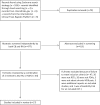Do Decision Aids Benefit Patients with Chronic Musculoskeletal Pain? A Systematic Review
- PMID: 31880805
- PMCID: PMC7209464
- DOI: 10.1093/pm/pnz280
Do Decision Aids Benefit Patients with Chronic Musculoskeletal Pain? A Systematic Review
Abstract
Objective: To review the effect of patient decision aids for adults making treatment decisions regarding the management of chronic musculoskeletal pain.
Methods: We performed a systematic review of randomized controlled trials of adults using patient decision aids to make treatment decisions for chronic musculoskeletal pain in the outpatient setting.
Results: Of 477 records screened, 17 met the inclusion criteria. Chronic musculoskeletal pain conditions included osteoarthritis of the hip, knee, or trapeziometacarpal joint and back pain. Thirteen studies evaluated the use of a decision aid for deciding between surgical and nonsurgical management. The remaining four studies evaluated decision aids for nonsurgical treatment options. Outcomes included decision quality, pain, function, and surgery utilization. The effects of decision aids on decision-making outcomes were mixed. Comparing decision aids with usual care, all five studies that examined knowledge scores found improvement in patient knowledge. None of the four studies that evaluated satisfaction with the decision-making process found a difference with use of a decision aid. There was limited and inconsistent data on other decision-related outcomes. Of the eight studies that evaluated surgery utilization, seven found no difference in surgery rates with use of a decision aid. Five studies made comparisons between different types of decision aids, and there was no clearly superior format.
Conclusions: Decision aids may improve patients' knowledge about treatment options for chronic musculoskeletal pain but largely did not impact other outcomes. Future efforts should focus on improving the effectiveness of decision aids and incorporating nonpharmacologic and nonsurgical management options.
Keywords: Aging; Chronic Pain; Musculoskeletal; Patient Decision Aid; Shared Decision-Making.
2019 American Academy of Pain Medicine. This work is written by US Government employees and is in the public domain in the US.
Figures
References
-
- Stuart I, Weinstein M, Edward H, Yelin P Sylvia I, Watkins-Castillo P. The burden of musculoskeletal diseases in the United States. 2014. Available at: http://www.boneandjointburden.org/2014-report/ib0/prevalence-select-medi... (accessed June 12, 2019).
-
- Hoy D, March L, Brooks P, Blyth F, Woolf A, Bain C.. The global burden of low back pain: Estimates from the Global Burden of Disease 2010 study. Ann Rheum Dis 2014;73(6):968–74. - PubMed
-
- Gunnar Andersson M PhD, Sylvia I, Watkins-Castillo P. The burden of musculoskeletal diseases in the United States. 2014. Available at: http://www.boneandjointburden.org/2014-report/ii0/spine-low-back-and-nec... (accessed June 12, 2019).
-
- Edward H, Yelin P, Miriam Cisternas M, Sylvia I, Watkins-Castillo P. The burden of musculoskeletal diseases in the United States. 2014. Available at: http://www.boneandjointburden.org/2014-report/x0/economic-cost (accessed June 12, 2019).
Publication types
MeSH terms
Grants and funding
LinkOut - more resources
Full Text Sources
Miscellaneous


